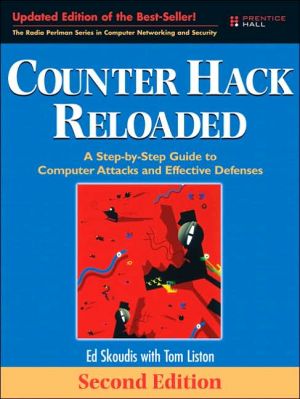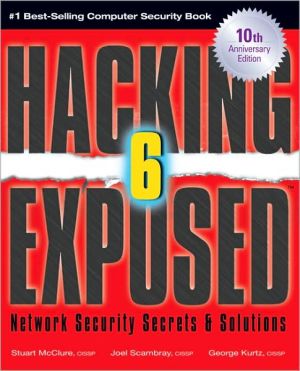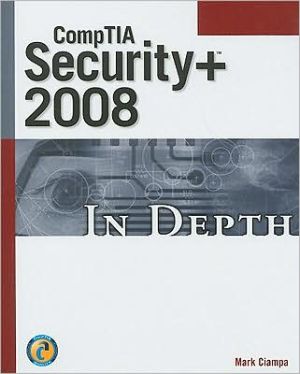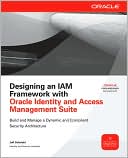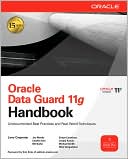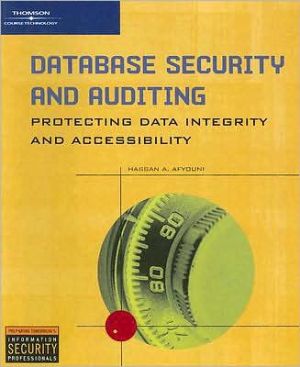Counter Hack Reloaded: A Step-by-Step Guide to Computer Attacks and Effective Defenses, 2nd Edition
“I finally get it! I used to hear words like rootkit, buffer overflow, and idle scanning, and they just didn’t make any sense. I asked other people and they didn’t seem to know how these things work, or at least they couldn’t explain them in a way that I could understand. Counter Hack Reloaded is the clearest explanation of these tools I have ever seen. Thank you!”\ —Stephen Northcutt, CEO, SANS Institute\ “Ed Skoudis does it again! With this new edition, Ed takes a phenomenal work to the...
Search in google:
Infrastructure network consultant Skoudis provides a step-by-step guide that will help network and system administrators defend their information and computing assets, whether or not they have had security experience. After reviewing TCP/IP, Unix, and Windows technology, he describes the most damaging attacks used by malicious hackers and how to stop them. The second edition covers Linux, Windows XP, wireless LANs, spyware, and new attack methods. Annotation © 2006 Book News, Inc., Portland, OR Booknews Infrastructure network consultant Skoudis provides a step-by-step guide that will help network and system administrators defend their information and computing assets, whether or not they have had security experience. The 13 chapters discuss a hacker's view of networks, TCP/IP protocols, and their vulnerabilities; five phases of hacking (reconnaissance, scanning, gaining and maintaining access, and preventing detection); the most dangerous and widespread attack scenarios; key hacker tools and how they work to build elegant attacks from simple building blocks; detecting and preventing IP spoofing, covert channels, denial of service, and other key attacks; how to uncover the handiwork of hackers; and a preview of tomorrow's hacker tools, attacks, and countermeasures. Annotation c. Book News, Inc., Portland, OR (booknews.com)
My flight had just landed. It was around midnight. The flight attendant announced that we could turn on our cell phones. As soon as mine booted up, it started buzzing with a frantic call from a newspaper reporter I had recently met. He quickly explained that he had obtained a copy of a manifesto written by a terrorist who had launched some pretty horrific attacks killing hundreds of innocent people a few months back. The reporter had had the text professionally translated so he could get some folks to analyze it. In this 30-page document, this very evil guy was urging his followers to alter their tactics in their struggle. To augment their physical terrorism, the plan was now to start including cyber attacks to maximize their impact on countries that oppose their terrorist agenda. The reporter wanted me to analyze the technical underpinnings of the manifesto, to determine whether it was all smoke and mirrors, or a legitimate cause for concern.\ I got to my hotel room and snagged a copy of the manifesto from my e-mail. The document I read startled me. Although not technically deep, it was quite astute. Its author emphasized that the terrorist group could enhance their stature and influence and cause more terror to their enemies by undermining their economic well-being through the use of computer attacks. After this really eerie “motivational” speech introduction, the manifesto turned toward describing how different categories of attack could be used to achieve terrorist goals. Although the author didn’t include technical details, he did provide a huge number of technical references on computer attacks, pressing his faithful followers to study hard the technologies of the infidel so they could undermine them.\ The following day I received an unrelated call, this time from a lawyer friend of mine. He explained that a computer attacker had broken into the network of a company and stolen over a million credit card numbers. Because the attacker had pilfered the entire magnetic stripe data stored on the company’s servers, the bad guy could create very convincing counterfeit cards, and begin selling them on the black market. My lawyer friend wanted me to look over the details of the heist and explain in nontechnical jargon how the thief was able to pull this off. I carefully reviewed the case, analyzing the bad guy’s moves, noting sadly that he had used some pretty standard attack techniques to perpetrate this big-time crime.\ Given those cases on back-to-back days, I just reread the preface to the original Counter Hack book I wrote almost five years ago. Although it described a real-world attack against an ISP, it still had a fun feeling to it. The biggest worry then was the defacement of some Web sites and my buddy’s boss getting mad, certainly cause for concern, but not the end of the world. I was struck with how much things have changed in computer attacks, and not at all for the better. Five years back, we faced a threat, but it was often manifested in leisurely attacks by kids looking to have some fun. We did face a hardened criminal here and there, of course, but there was a certain whimsy to our work. Today, with organized crime and, yes, even terrorists mastering their computer attack skills, things have taken a turn for the dark and sinister. Sure, the technology has evolved, but increasingly so has the nature of our threat.\ Underscoring the problem, if you place an unpatched computer on the Internet today, its average survival time before being completely compromised is less than 20 minutes. That time frame fluctuates a bit over the months, sometimes dropping to less than 10 minutes, and occasionally bumping up over 30 minutes when some particularly good patches are released and quickly deployed. However, even the upper-end number is disheartening. Given this highly aggressive threat, it’s even more important now than ever for computer professionals (system administrators, network administrators, and security personnel) and even laymen to have knowledge of how the bad guys attack and how to defend against each of their moves. If we don’t understand the bad guys’ tactics and how to thwart them, they’ll continue to have their way with our machines, resulting in some major damage. They know how to attack, and are learning more all the time. We defenders also must be equally if not better equipped. This new edition of Counter Hack represents a massive update to the original book; a lot has happened in the last five years in the evolution of computer attack technology. However, the book retains the same format and goal: to describe the attacks in a step-by-step manner and to demonstrate how to defend against each attack using time-tested, real-world techniques.\ Oh, and one final note: Although the nature of the threat we face has grown far more sinister, don’t let that get you down in the dumps. A depressed or frightened attitude might make you frustrated and less agile when dealing with attacks, lowering your capabilities. If we are to be effective in defending our systems, we must keep in mind that this information security work we all do is inherently interesting and even fun. It’s incredibly important to be diligent in the face of these evolving threats; don’t get me wrong. At the same time, we must strive to keep a positive attitude, fighting the good fight, and making our systems more secure.\ Preface from the First Edition\ My cell phone rang. I squinted through my sleepy eyelids at the clock. Ugh! 4 AM, New Year’s Day. Needless to say, I hadn’t gotten very much sleep that night.\ I picked up the phone to hear the frantic voice of my buddy, Fred, on the line. Fred was a security administrator for a medium-sized Internet Service Provider, and he frequently called me with questions about a variety of security issues.\ “We’ve been hacked big time!” Fred shouted, far too loudly for this time of the morning.\ I rubbed my eyes to try to gain a little coherence.\ “How do you know they got in? What did they do?” I asked.\ Fred replied, “They tampered with a bunch of Web pages. This is bad, Ed. My boss is gonna have a fit!”\ I asked, “How did they get in? Have you checked out the logs?”\ Fred stuttered, “W-Well, we don’t do much logging, because it slows down performance. I only snag logs from a couple of machines. Also, on those systems where we do gather logs, the attackers cleared the log files.”\ “Have you applied the latest security fixes from your operating system vendor to your machines?” I asked, trying to learn a little more about Fred’s security posture.\ Fred responded with hesitation, “We apply security patches every three months. The last time we deployed fixes was ... um ... two-and-a-half months ago.”\ I scratched my aching head and said, “Two major buffer overflow attacks were released last week. You may have been hit. Have they installed any rootkits? Have you checked the consistency of critical files on the system?”\ “You know, I was planning to install something like Tripwire, but just never got around to it,” Fred admitted.\ I quietly sighed and said, “OK. Just remain calm. I’ll be right over so we can start to analyze your machines.”\ You clearly don’t want to end up in a situation like Fred, and I want to minimize the number of calls I get at 4 AM on New Year’s Day. While I’ve changed Fred’s name to protect the innocent, this situation actually occurred. Fred’s organization had failed to implement some fundamental security controls, and it had to pay the price when an attacker came knocking. In my experience, many organizations find themselves in the same state of information security unpreparedness.\ But the situation goes beyond these security basics. Even if you’ve implemented all of the controls discussed in this Fred narrative, there are a variety of other tips and tricks you can use to defend your systems. Sure, you might apply security patches, use a file integrity checking tool, and have adequate logging, but have you recently looked for unsecured modems? Or, how about activating port-level security on the switches in your critical network segments to prevent powerful, new active sniffing attacks? Have you considered implementing nonexecutable stacks to prevent one of the most common types of attacks today, the stack-based buffer overflow? Are you ready for kernel-level rootkits? If you want to learn more about these topics and more, please read on.\ As we will see throughout the book, computer attacks happen each and every day, with increasing virulence. To create a good defense, you must understand the offensive techniques of your adversaries. In my career as a system penetration tester, incident response team member, and information security architect, I’ve seen numerous types of attacks ranging from simple scanning by clueless kids to elite attacks sponsored by the criminal underground. This book boils down the common and most damaging elements from these real-world attacks, while offering specific advice on how you can proactively avoid such trouble from your adversaries. We’ll zoom in on how computer attackers conduct their activities, looking at each step of their process so we can implement in-depth defenses.\ The book is designed for system administrators, network administrators, and security professionals, as well as others who want to learn how computer attackers do their magic and how to stop them. The offensive and defensive techniques laid out in the book apply to all types of organizations using computers and networks today, including enterprises and service providers, ranging in size from small to gigantic.\ Computer attackers are marvelous at sharing information with each other about how to attack your infrastructure. Their efficiency at information dissemination about victims can be ruthless. It is my hope that this book can help to even the score, by sharing practical advice about how to defend your computing environment from the bad guys. By applying the defenses from this book, you can greatly improve your computer security and, perhaps, we’ll both be able to sleep in late next New Year’s Day.\ Acknowledgments\ I was surprised to find that writing a new edition for a book was even harder than writing the original book! Deciding what to keep and what to drop is very tough, but I think we’ve struck the right balance. The consistently good input I got from my reviewers made me revise the book significantly and really contributed to this process. My more technical reviewers wanted deeper technical detail, and the less technical folks wanted more tutorial and background. In the end, I am very grateful for all of the wonderful input regarding the balance between the importance of background material and the need for technical details.\ In particular, Radia Perlman was instrumental in the development of this book. She originally had the idea for writing it, and finally motivated me to get started writing. She also guided me through the writing process, providing a great deal of support and excellent technical feedback. Many thanks to Radia, the great Queen of Networking!\ Catherine Nolan from Prentice Hall was crucial in kicking me in the rear to move this whole process forward. She was firm yet friendly, inspiring me with her e-mails to keep making progress every day.\ Mary Franz from Prentice Hall was an inspiring friend, helping to get this revised edition started. This book wouldn’t exist if it weren’t for Mary. She’s now moved on to other opportunities, and I do indeed miss her.\ Also, thanks to everyone else at Prentice Hall for their support in getting this done, especially Julie Nahil and Teresa Horton, who shepherded this puppy through the editing process and provided much helpful input.\ Thank you also to Harlan Carvey, Kevin Fu, Mike Ressler, and Warwick Ford, who reviewed this book and provided very useful comments. Also, Denise Mickelsen was very helpful in organizing things throughout the review process.\ I’d like to thank Tom Liston, a great friend, who did the updates on Chapters 4, 8, and 11. Without Tom’s excellent work on those chapters, I’m not sure we’d have ever finished. Thanks a bunch!\ Allan Paller and Stephen Northcutt, from the SANS Institute, have done a tremendous job pushing me to develop my presentation and writing style. I’ve always appreciated their input regarding how to present these concepts in a fun, informative, and professional way.\ Also, many thanks go the authors of the tools described throughout the book. Although a small number of the tool developers have sinister motives, the vast majority are focused on helping people find security flaws before the attackers do. Although you might disagree about their motivations, the skill and dedication that goes into devising these tools and attack strategies are remarkable and must not be understated.\ The students who’ve attended my live course over the past decade have provided a huge amount of input and clarification. Often, a small comment on the feedback forms has led to some major changes in my materials that have greatly improved the coherence and value of the presentation materials and this book. Thanks to all who have contributed over the years!\ But most important, I’d like especially to thank my wonderful wife, Josephine, and our children, Jessica and Joshua, for their help and understanding throughout this process. They were incredibly supportive while I wrote away day and night, giving me far more leeway and understanding than I deserve. It wasn’t easy, but it was fun ... and now it’s done.
(NOTE: Each chapter concludes with Summary). Foreword. Preface Reloaded. About the Authors. 1. Introduction. The Computer World and the Golden Age of Hacking. Why This Book? The Threat: Never Underestimate Your Adversary. A Note on Terminology and Iconography. Caveat: These Tools Could Hurt You. Organization of Rest of the Book. 2. Networking Overview: Pretty Much Everything You Need to Know About Networking to Follow the Rest of This Book. The OSI Reference Model and Protocol Layering. How Does TCP/IP Fit In? Understanding TCP/IP. Transmission Control Protocol (TCP). User Datagram Protocol (UDP). Internet Protocol (IP) and Internet Control Message Protocol (ICMP). ICMP. Other Network-Level Issues. Don’t Forget About the Data Link and Physical Layers! Security Solutions for the Internet. Conclusion. 3. Linux and UNIX Overview: Pretty Much Everything You Need to Know About Linux and UNIX to Follow the Rest of This Book. Introduction. Architecture. Accounts and Groups. Linux and UNIXPermissions. Linux and UNIX Trust Relationships. Common Linux and UNIX Network Services. Conclusion. 4. Windows NT/000/XP/00 Overview: Pretty Much Everything You Need to Know About Windows to Follow the Rest of This Book. Introduction. A Brief History of Time. The Underlying Windows Operating System Architecture. How Windows Password Representations Are Derived. Kernel Mode. From Service Packs and Hotfixes to Windows Update and Beyond. Accounts and Groups. Privilege Control. Policies Trust. Auditing. Object Access Control and Permissions. Network Security. Windows 2000 and Beyond: Welcome to the New Millennium. Conclusion. 5. Phase 1: Reconnaissance. Low-Technology Reconnaissance: Social Engineering, Caller ID Spoofing, Physical Break-In, and Dumpster Diving. Search the Fine Web (STFW). Who is Databases: Treasure Chests of Information. The Domain Name System. General-Purpose Reconnaissance Tools. Conclusion. 6. Phase 2: Scanning. War Driving: Finding Wireless Access Points. War Dialing: Looking for Modems in All the Right Places. Network Mapping. Determining Open Ports Using Port Scanners. Vulnerability-Scanning Tools. Intrusion Detection System and Intrusion Prevention System Evasion. Conclusion. 7. Phase 3: Gaining Access Using Application and Operating System Attacks. Script Kiddie Exploit Trolling. Pragmatism for More Sophisticated Attackers. Buffer Overflow Exploits. Password Attacks. Web Application Attacks. Exploiting Browser Flaws. Conclusion. 8. Phase 4: Gaining Access Using Network Attacks. Sniffing. IP Address Spoofing. Session Hijacking. Netcat: A General-Purpose Network Tool. Conclusion. 9. Phase 3: Denial-of-Service Attacks. Locally Stopping Services. Locally Exhausting Resources. Remotely Stopping Services. Remotely Exhausting Resources. Conclusion. 10. Phase 4: Maintaining Access: Trojans, Backdoors, and Rootkits ... Oh My! Trojan Horses. Backdoors. The Devious Duo: Backdoors Melded into Trojan Horses. Nasty: Application-Level Trojan Horse Backdoor Tools. Also Nasty: The Rise of the Bots. Additional Nastiness: Spyware Everywhere! Defenses Against Application-Level Trojan Horse Backdoors, Bots, and Spyware. Even Nastier: User-Mode Rootkits. Defending Against User-Mode Rootkits. Nastiest: Kernel-Mode Rootkits. Defending Against Kernel-Mode Rootkits. Conclusion. 11. Phase 5: Covering Tracks and Hiding. Hiding Evidence by Altering Event Logs. Defenses Against Log and Accounting File Attacks. Creating Difficult-to-Find Files and Directories. Hiding Evidence on the Network: Covert Channels. Defenses Against Covert Channels. Conclusion. 12. Putting It All Together: Anatomy of an Attack. Scenario 1: Crouching Wi-Fi, Hidden Dragon. Scenario 2: Death of a Telecommuter. Scenario 3: The Manchurian Contractor. Conclusion. 13. The Future, References, and Conclusions. Where Are We Heading? Keeping Up to Speed. Final Thoughts ... Live Long and Prosper. Index.
\ From Barnes & NobleThe Barnes & Noble Review\ Five years ago, says top infosec expert Ed Skoudis, attacks on corporate computer systems were more likely to come from kids than hardened criminals. Now, though, “with organized crime and, yes, even terrorists mastering their computer attack skills, things have taken a turn for the dark and sinister.” When Skoudis sat down to rewrite his classic Counter Hack, he had his hands full. The result: a new book that’s every bit as useful to IT people as the original, and even more urgently important. \ As in the first edition, Skoudis carefully describes the entire attack process: reconnaissance, scanning, and the methods used by attackers to gain, maintain, and hide their access. Skoudis addresses both UNIX/Linux and Windows environments and presents state-of-the-art countermeasures for the exploits he discusses. From wardriving to kernel-mode rootkits, this book tells you what you must know -- and what you must do. Bill Camarda, from the February 2006 Read Only\ \ \ \ \ \ Infrastructure network consultant Skoudis provides a step-by-step guide that will help network and system administrators defend their information and computing assets, whether or not they have had security experience. The 13 chapters discuss a hacker's view of networks, TCP/IP protocols, and their vulnerabilities; five phases of hacking (reconnaissance, scanning, gaining and maintaining access, and preventing detection); the most dangerous and widespread attack scenarios; key hacker tools and how they work to build elegant attacks from simple building blocks; detecting and preventing IP spoofing, covert channels, denial of service, and other key attacks; how to uncover the handiwork of hackers; and a preview of tomorrow's hacker tools, attacks, and countermeasures. Annotation c. Book News, Inc., Portland, OR (booknews.com)\ \ \ Soundview Executive Book SummariesSkoudis, a leading network security expert, has compiled his wealth of knowledge on protecting information and computing assets into a 564-page masterwork. Sharing his insider's view on the destructive tools and tactics used by hackers, Skoudis offers an encyclopedia of hacker tools, attack detecting techniques and preventive measures to protect the vulnerabilities of today and tomorrow. Copyright (c) 2002 Soundview Executive Book Summaries\ \
